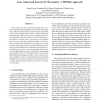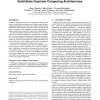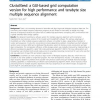3628 search results - page 95 / 726 » Approaching the Physical Limits of Computing |
ICPR
2004
IEEE
14 years 11 months ago
2004
IEEE
The accuracy of a 3D reconstruction using laser scanners is significantly determined by the detection of the laser stripe. Since the energy pattern of such a stripe corresponds to...
GEOS
2007
Springer
14 years 4 months ago
2007
Springer
Spatio-temporal network is defined by a set of nodes, and a set of edges, where the properties of nodes and edges may vary over time. Such networks are encountered in a variety of...
SPAA
2003
ACM
14 years 3 months ago
2003
ACM
Quantum computation has become an intriguing technology with which to attack difficult problems and to enhance system security. Quantum algorithms, however, have been analyzed un...
DAGSTUHL
2007
13 years 11 months ago
2007
: This is a position paper introducing blob computing: A Blob is a generic primitive used to structure a uniform computing substrate into an easier-to-program parallel virtual mach...
BMCBI
2010
13 years 10 months ago
2010
Background: There is an increasing demand to assemble and align large-scale biological sequence data sets. The commonly used multiple sequence alignment programs are still limited...



